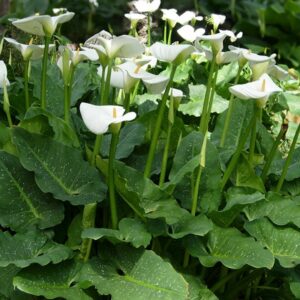Your cart is currently empty!
Calla Lilies in Ground: A Comprehensive Guide to Planting, Care, and Enjoyment

Introduction
Calla lilies (Zantedeschia) are striking and elegant flowers that add a touch of sophistication to any garden. Whether in vibrant hues or classic whites, their trumpet-shaped blooms can bring joy and beauty to your outdoor space. This comprehensive guide will equip you with all the knowledge you need to successfully plant, care for, and enjoy calla lilies in the ground.
Choosing the Right Calla Lily Varieties
There are numerous varieties of calla lilies, each with unique characteristics. Before planting, it’s crucial to select varieties that suit your climate and preferences:
- Hardy Calla Lilies (Z. aethiopica):
These calla lilies are native to South Africa and can tolerate colder temperatures (USDA hardiness zones 6-9). They produce large, white blooms with a prominent yellow spadix.
- Tender Calla Lilies:
Tender varieties, such as Z. elliottiana and Z. rehmannii, thrive in warmer climates (USDA hardiness zones 9-11). They come in various colors, including pink, yellow, orange, and purple.
Planting Calla Lilies in Ground
- Soil Preparation:
Calla lilies prefer well-drained, fertile soil with a pH between 6.0 and 6.5. If your soil is heavy, amend it with organic matter like compost or peat moss.
- Planting Time:
Hardy calla lilies can be planted in early spring or fall. Tender varieties should be planted after the last frost date when the soil has warmed up.
- Planting Depth:
Plant calla lilies with the “nose” (where the roots attach to the corm or tuber) pointing upwards. The top of the corm should be about 2 inches below the soil surface.
- Spacing:
Space the corms 12-18 inches apart to allow for proper growth and air circulation.
Care for Calla Lilies in Ground
- Watering:
Water calla lilies deeply and regularly, especially during hot and dry weather. Allow the soil to dry out slightly between waterings.
- Fertilizing:
Fertilize calla lilies monthly during the growing season with a balanced fertilizer.
- Deadheading:
Remove spent blooms to encourage new flower production and prevent seed formation.
- Dividing:
Calla lilies can become overcrowded with time. Divide them every 3-4 years by lifting the corms and separating the offsets.
Winter Care
In cold climates, hardy calla lilies will naturally go dormant during the winter. Mulch around the plants with a layer of straw or compost to protect the corms from freezing temperatures.
For tender calla lilies, you can either dig them up and store them indoors in a cool, dark place, or leave them in the ground and protect them with a thick layer of mulch.
Common Pests and Diseases
Calla lilies are generally disease-resistant, but they can be susceptible to certain pests and diseases:
- Aphids:
These tiny pests can feed on the foliage and stems, causing yellowing and stunted growth. Use insecticidal soap or neem oil to control them.
- Thrips:
Thrips are small insects that can cause silvery streaks and spots on the leaves. Use a systemic insecticide to eliminate them.
- Bacterial Soft Rot:
This disease can cause the corms to rot and wilt. Remove and discard infected plants and practice good garden hygiene to prevent its spread.
Enjoy the Beauty of Calla Lilies
With proper care and attention, calla lilies will thrive in your garden and bring you years of enjoyment. Their stunning blooms make excellent cut flowers for bouquets and arrangements, adding an elegant touch to any occasion.
Whether in a solitary pot or grouped in a vibrant display, calla lilies are a versatile and rewarding addition to any garden landscape. Their beauty and ease of care make them a favorite among gardeners worldwide.
Additional Tips
*
- Calla lilies prefer partial shade, receiving a few hours of sunlight per day.
*
- Keep the foliage dry to prevent fungal diseases.
*
- Calla lilies are poisonous to pets, so take precautions if you have animals.
*
- Enjoy the beautiful flowers of calla lilies throughout the season, and remember to divide and replant them to keep your garden blooming for years to come.








Leave a Reply